Klytia (1930-1945)
Continued from: Klytia
Continued onto: Klytia (post 1945)
In January, 1930, Klytia’s founder, Marie-Elise Valentin Le Brun, died and her place was taken by her daughter, Henriette Valentin Font. In February, 1930, the capital of the business was increased to ₣6 million and the new management then began to modernise the business.
In 1931, a new logo for the company was trademarked. It consisted of interlocking letters ‘I’ and ‘B’ (for Institut de Beauté) surmounted by crown. A variation of this logo had been used on some Klytia products in the late 1920s but it was now extended across most new lines. To help differentiate the company, a bust of Klytia also began to be featured more frequently in advertising and Klytia was used in more product names; e.g., Klytiaplasme, Klytianet, Klytiafar, and Royal Klytia.
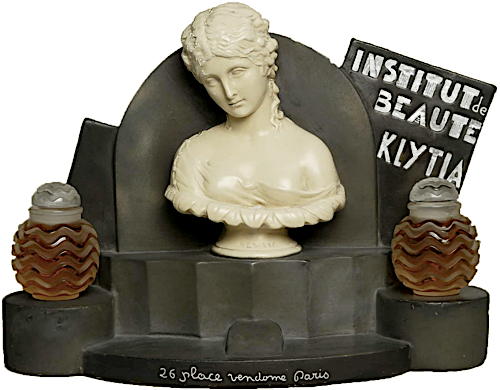
Above: Display stand with a copy of a Roman bust of Klytia/Clytie (40-50 CE) along with spaces for Klytia products. The Lalique containers may not have been been part of the original display.
The new logo worked well on the new packaging designs which featured cleaner more geometric lines. These novel designs were generally restricted to new lines with older products largely keeping to their original packaging. However, there were some exceptions. For example, around 1935 Klytia changed the bottle used for Beauté de l’Impératrice No. 310, one of its préparations de grande beauté, placing it in a new glass container from Lalique.
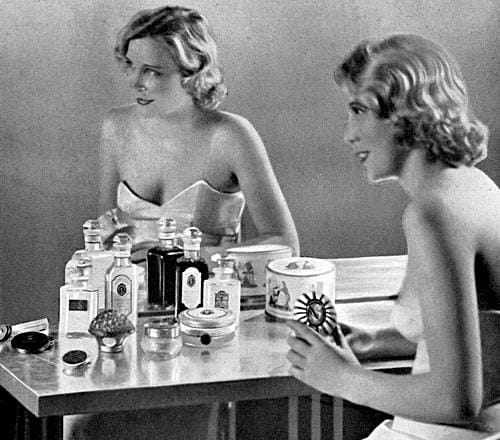
Above: 1933 An assortment of Klytia products in a mixture of old and new packaging. The woman is holding a box of Poudre Elayne. Behind this is a box of Ma Poudre Préféré 1830. To the left is a jar of Crème Velours Klytia in an ornate glass container.
United States
Klytia’s attempt to establish itself in America was abandoned in the 1930s. The Klytia Corporation established in New York in 1929 seems to have been a casualty of the stock market crash. In 1931, it was replaced by a new company, The Professeur Raimon Institut de Beauté, Inc. (capital: US$100,000), with Professor Albert Raimon as president and Pierre Bourdain as secretary and general manager. Offices were established at 315 Fifth Avenue, New York with a treatment salon opened at 47 West 57th Street in conjunction with Cluzelle Brothers, hairdressers. In 1932, the offices were moved to 333 West 52nd Street where the factory was based. Unfortunately, in December, 1933, Pierre Bourdain died suddenly of a brain tumour when he was only twenty-eight. This event, and the deepening depression, appears to have been the death knell for Klytia in America and all trace of it there vanishes. Professor Albert Raimon moved on to establish other businesses.
Britain
In 1935, Klytia Ltd. (capital: £100) was established in London, presumably to help get around some of the import duties Britain placed on foreign companies during the 1930s. I know very little about the company’s activities except that it opened a salon at 27 Old Bond Street, London. This seems to have operated through to the outbreak of the Second World War when it went out of business.
Salon
In 1936, Klytia modernised the salon at 26 Place Vendôme using the interior designer Jean Pascaud [1903-1966].
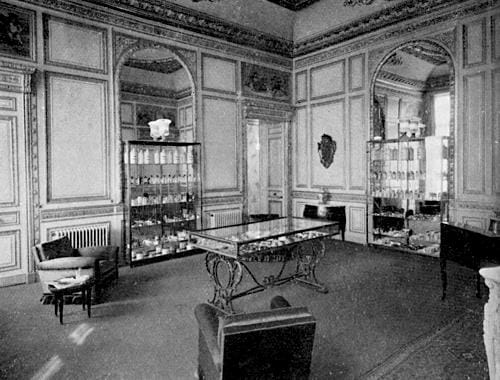
Above: 1936 Klytia Institut de Beauté sale room with product displays.
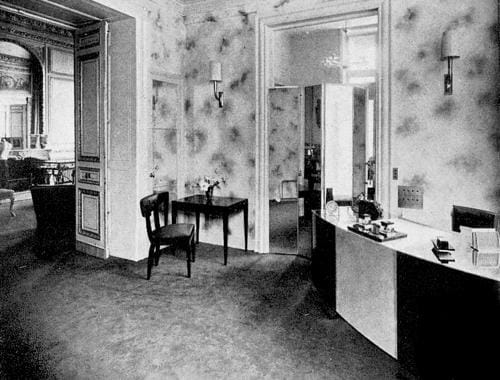
Above: 1937 Klytia Institut de Beauté reception. The sales room is on the left and the door on the right leads to treatment rooms.
Clutter was removed and the treatment rooms were updated with modern fittings including Surrepos chairs designed by Dr. Jean Pascaud [1903-1966]. These could be tilted back to place the client in a reclining position.
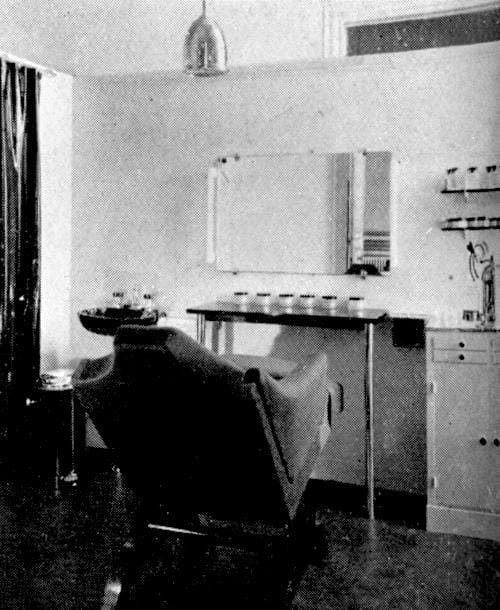
Above: 1936 Klytia Institut de Beauté treatment room. The Surrepos chair sits in front of a mirror above a black glass shelf with products. There is a sink (left) and a pulveriser is sitting on a shelf (right).
Salon treatments
I have very little information on any new treatments introduced into the Vendôme salon during the 1930s. There are mentions of an Atomos machine, widely used in French salons for ‘traitements carbo-gazeux’ which sprayed compressed carbon dioxide over the skin. This was supposed to produced a number of beneficial effects including improved circulation.
See also: Carbonic Gas Sprays
There are also references to paraffin baths and faradic treatments. Paraffin baths were once widely employed to help clients lose weight while faradic treatments were used to strengthen and firm muscles by ‘exercising” them with electrical contractions. However, it is possible that one or both of these treatments were available in the Paris salon before 1930.
See also: Paraffin Wax Treatments and Faradic Treatments
Vapozone treatments were introduced into the salon in the late 1930s. These used an electrical vaporiser to spray the face with a water containing ozone generated by a spark gap.
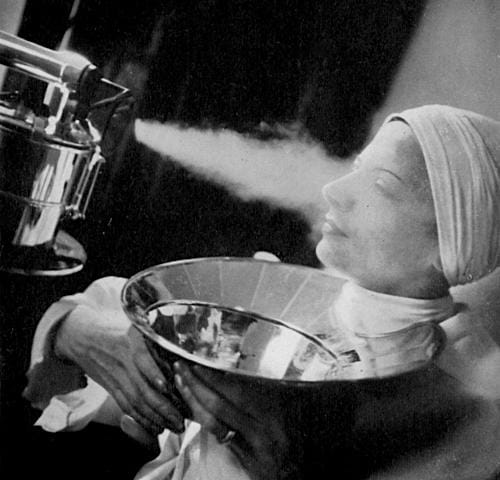
Above: 1937 Klytia Vapozone treatment.
Ozone acts as a disinfectant so the treatments were generally done on women with oily skin suffering from pimples or acne. A similar effect on the small scale could be produced using a high-frequency machine which also generates ozone from a spark. These vaporisers became fairly common in the 1930s and continued to be used until the dangers of ozone were recognised.
See also: Vaporisers (Steamers & Atomisers) and High-Frequency Treatments
Treatment routines
Klytia continued to divide women in four age groups – 18-25, 25-35, 35-50, and over 50 – for its suggested skin-care routines but these were more than those recommended at the turn of the century due to the use of additional cosmetics. Below is an example for women aged over 50.
Aged over 50
Oily skin:
Evening: Remove make-up and clean the skin with a large cotton pad soaked in Tonic Princesse No. 51. Wet this pad again with Lotion Anti Séborrhée No. 306, apply and let it dry. With a light massage from bottom to top, then apply a little Crème Antirides No. 320, and leave on overnight.
Morning: Wash the face with hot water mixed with Poudre Lactee No. 16 using a cotton pad. Use this same pad to clean the face with a little Crème Savonneuse No. 49. turn the pad over and apply a little Crème Soleil d’Or No. 274 using it to complete the facial cleansing, then rinse in the previously prepared hot water. Refresh the epidermis with Lotion de Madame No. 326. Add a little Crème Djavidan No. 162 on the damp skin, then a hint of Fard Studio No. 263 on the cheeks before powdering.
Dry skin:
Evening: Remove make-up and clean the skin with a large cotton pad soaked in Tonic No. 13 to which a little Crème Onctueuse No. 40 has been added. Turn the pad over and use it to remove everything from the face. Then put a little Crème a la Pulpe d’Abricot No. 381 and leave on overnight.
Morning: Wash the face with warm water mixed with Amandine powder No. 52 using a cotton pad. On this same pad take a little Crème au Miel No. 101 and use it to clean the face, then rinse in the previously prepared warm water. Refresh the epidermis with Lotion No. 86. Add a little Au Suc de Concombres No. 127, rinse well, wiping lightly. Then put a hint of Fard Gras No. 221 on the cheeks before powdering.
Normal skin:
Evening: Remove make-up and clean the skin with a large cotton pad soaked with Tonic No. 13. Then add a little Cold Cream No. 43 and use it to clean the face. Using a new cotton pad, apply Huile Persane No. 254 all over the face, let dry and keep on overnight.
Morning: Wash the face with water mixed with Fleurs et Farine de Mon Moulin No. 266 using a cotton pad. On this same pad take a little Cold Cream No. 43 and use it to clean the entire face, then rinse in the previously prepared water. Refresh the epidermis with Lotion Klytia No. 52. Add a little Crème Djavidan No. 162 on the damp skin, then put a hint of Fard Studio No. 263 on the cheeks before powdering.(Modified from Klytia, c.1930)
Most of the skin-care and make-up lines in these suggested routines had been added after Klytia had opened and further lines were added during the 1930s.
Skin-care
As mentioned earlier, many of the new lines added in the 1930s included Klytia in their name. Those that i know of include: Crème Kytianet No. 353 (1931); Klytiaplasme Super Anti-rides No. 821 (1932); Crème Klytia Radium No. 827 (1934); and Yaourt Klytia No. 851 (1939).
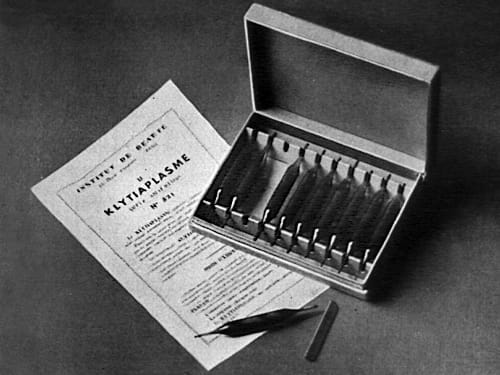
Above: 1932 Institut de Beauté Klytiaplasme No. 821.
Crème Kytianet No. 353: A cleansing cream for oily skin. Applied with a pad soaked in warm water to which Poudre Lactée No. 16 has been added.
Klytiaplasme No. 821: An anti-wrinkle serum that softens the skin and enriches the blood capillaries. Left on the skin for two hours or preferably overnight in the ten-day treatment .
Crème Klytia Radium No. 827: Revitalises and restore the skin. Can be used as a powder base. Use over Lotion Infante Eulalia No. 77.
Yaourt Klytia No. 851: Made with a yoghurt base. Applied with a pad soaked in Lotion Madame No. 326 or Lotion de Beauté No. 34.
I assume Crème Klytia Radium No. 827, later renamed Crème Klytia Radieuse, contained a small quantity of radium so was radioactive. Like Klytiaplasme it was supposed to reduce wrinkles and restore the youthfulness of the skin. It was not Klytia’s first Klytia radioactive line as the company had been selling an assortment of radioactive straps and masks in the 1920s along with Derydor No. 352, a once-a-week masque made with irradiated earths.
Other new lines introduced by Klytia in the 1930s included Émail Pintanier No. 342 (1931), and Crème Citron No. 882. Émail Pintanier was a new addition to Klytia’s préparations de grand beauté range. Used as a powder base and complexion improver it only came in one shade – Ocre Ému while Crème Citron looks to have been a standard lemon cream for oily skin types .
Masks
Masks/masques became increasingly popular as a salon treatment in the 1930s and Klytia added a few new lines to its previous items such as Fleures et Farines de Mon Moulin No. 266, and Derydor No. 352. By 1936, Klytia had added Masque Éclaire No. 384 a quick liquid mask that only needed to be left on for 15 minutes, and Masque Studio Klytia No 385 which appears to have been a copy of the Hollywood Mask introduced into France in 1935.
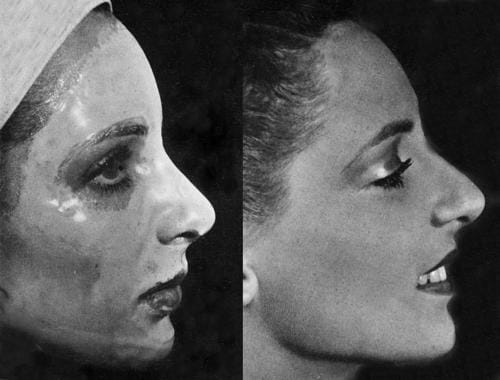
Above: 1936 Masque Studio No. 385. Like the Hollywood Mask it was peeled off after it set.
See also: Hollywood Mask
Later in the decade Klytia added Masque Crème No. 853, a mineral mask with a strong astringent action.
Depilatories
Klytia discontinued some of its early hair removers but persisted with its cream and powder depilatories – Crème Opéra No. 67 and Poudre Rose Épilatoire No. 69 – as well as Lotion Épilatoire Progressive No. 105, a hair ‘weakener’ which seems to have been renamed as Lotion Dépilatoire Progressive.
New additions included Cire Épilatoire No. 826, a wax, and Épil-Gum Klytia, a gum. I assume that both were used to trap hair which was then ripped from the skin. Hair removers of this type became more common in the 1930s with waxing going on to be a staple salon treatment.
See also: Waxing
Sun-care
In 1935, Klytia added Huile Phebus No. 829 to its sun-care range. Designed as a preventative, it was packaged with its sister line, Crème Phébus No. 292, with a label inspired by the tropics. Crème Phébus could be used at night to calm irritation caused by sunburn but was also recommended to calm skin irritated by cold weather .
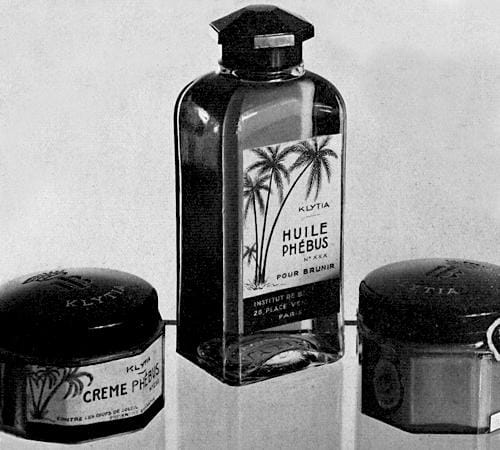
Above: 1936 Crème Phébus No. 292, Huile Pébus No. 829, and the Mauresque shade of Sève Madrilène No. 260. Sève Madrilène had previously only been available in tubes in Blanc, Rachel, and Chair Naturelle shades.
Huile Phébus No. 829: Helps brown the skin while preserving it from sunburn.
To achieve a darker skin tone without suntanning women could also use a dark foundation and/or with two new products along this line – Or Ambré No. 845, and Beauté de Iles No. 846 – released in 1938. More about them later.
Make-up
A Klytia make-up routine from the early 1930s is a little unusual as it recommends using a cream rouge before, and a powder rouge after powdering then doing the same with a cream and powder eyeshadow. The addition of a beauty spot is also atypical with Klytia selling these right up until the Second World War.
A. Apply a foundation cream according to the skin;
B. Put Rouge Gras 221 on dry skin, or Rouge Gras 263 if the skin is oily or neutral skin;
C. Powder with one of the different Klytia powders;
D. Emphasise eyelashes and eyebrows with Crayon No. 237;
E. Form, straighten and lengthen eyelashes and eyebrows with Beauté des Yeux No.229;
F. Shape the eye with the Crayon No. 671;
G. Whiten the nose, chin or lobe of the ears or blush it with Fard No. 263;
H. Shade the eyelids with Fard No. 263 or 169;
I. Satin the lips with Crayon No. 233 or 245;
J. Give the complexion a velvety and transparent appearance and make make-up invisible with Fard No. 243, 267 or 271;
K. Shade the eyelids with Pastel No. 858 or 225;
L. Put on a beauty spot.(Translated from Klytia, c.1930, p. 12)
Foundations
Klytia continued to sell a large number of creams that could function as foundations. Older products included Crème de Beauté No. 24, Crème Montespan No. 120, Crème Djavidan No. 162, Crème Idéal Fatale Beauté No. 116, and Crème Mousse Mousse No. 139.
In 1931, Klytia added Crème Nacrée Velours Klytia No. 347 packaged in a glass container designed to look like a bouquet of roses. However, as other creams could be used under powder, the previously mentioned Crème Radium No. 827 added in 1935 could also claim to be a new foundation.
Créme Velours Klytia: Softens, whitens and makes the skin feel like velvet. Holds powder well. Best used on skin moistened with Lotion No. 86.
In 1938, Klytia added three new ‘fonds de teint’ – Duvet de Pêche No. 844, Or Ambré No. 845, and Beauté de Iles No. 846. Although they could be used under powder they are probably best considered to be cream or liquid powders.
Duvet de Pêche No. 844: After shaking spread the product evenly with your fingers over wet skin. Allow to dry and then wipe finely with a fine cloth before applying rouge and powder. Shades: Blanc, Rachel, Naturel, Ocre, Mauresque, Abricot, and Coromandel.
Or Ambré No. 845: After cleansing the skin spread over the skin with your fingers or a brush. Apply. ore than once to achieve a darker shade. suitable for use on the face or body. Only one shade.
Beauté de Iles No. 846: Cleanse the skin and after it is dry apply the foundation with your fingers the rouge and powder. Shades: Coromandel, and Estérel.
Powders
Klytia continued to sell a wide variety of face powders through the 1930s including long-standing products such as Poudre de Riz Klytia No. 1, Poudre de Riz Eulalia, No. 5, and Poudre Élayne No. 238. The only record I have for a new entrant is Poudre Elisabeth No. 850 which debuted in 1939. Coincidentally, this was the same year that Elizabeth Arden moved her Paris salon to 7 Place Vendôme.
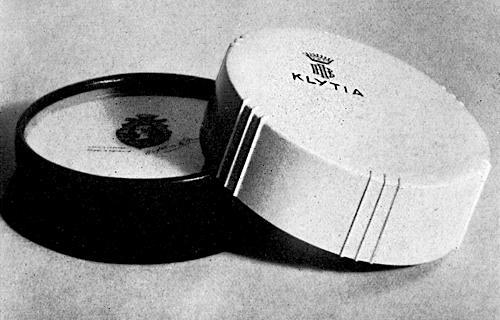
Above: 1939 Poudre Elisabeth. It was scented with Parfum Elisabeth and came in 24 shades.
Lipsticks
Klytia first new lipstick added in the 1930s was Royal Klytia No. 348, introduced in 1931. Unfortunately, I have no information on its case or shade range. In 1934, Klytia created a second new lipstick, Paris-Méditerranée No. 355, an indelible housed in a black push-up case made from Galalithe (Galalith), generally recognised as the first synthetic plastic. It was developed in France at the turn of the century from milk casein treated with formaldehyde. Klytia’s third lipstick for the decade was an automatic. Debuting in 1937, Automatique Klytia No. 843 came in a rectangular metal case that used a push-up mechanism to open the lid.
Paris-Méditerranée No. 355: A creamy indelible lipstick that does not dry the lips. Shades: Rouge Gorge, Coqueliucot, Stop, and Framboisé. Later shades included Rouge Orange, Groseille, Aubergine, and Lumineux.
Automatique Klytia No. 843: Helps keep the lips smooth and flexible. Shades: Jaffa, Coromandel, Sarah, Montmorency, and Grenade.
Rouges
Klyia continued to provide its clients with a range of powder, cream and liquid rouges. There were over twenty different rouges in the Klytia inventory in the 1920s and some rationalisation took place in the 1930s. On the plus side those rouges that did survive often came in a wider range of shades. For example, Rouge de l’Imperatice No. 226 had its shade range extended from Teinte Claire 1 and Teint Foncée 2 in the late 1920s, to Jaffa, Rouge-Gorge, Rouge Sarah, Coeur de Grenade, Coromandel, Cyclamen, Rose Tendre, Aubergine, and Pétales de Rose in the years leading up to the war.
Klytia added two new rouges in the 1930s, Klytiafar No. 346 in 1931 and Tamilklytia No. 840 in 1936. Like the Paris-Méditerranée lipstick, Klytiafar came in a black Galalithe case. Tamiklytia on the other hand was sold in a white container with a built in puff.
Eye make-up
There were a few additions to Klytia’s range of eye make-up in the 1930s. Crayon des Yeux No. 830 which functioned as an eyeliner and an eyebrow pencil looks to have replaced the previous Crayon des Yeux No. 237 sold earlier in the decade.
Klytiacil No. 828, which debuted in 1935, was a block mascara made with castor oil and whatever was in Beauté Ciliare No. 47, an eyelash grower. It came with two brushes, the smaller brush perhaps helping to separate the lashes. Unlike the Crayon des Yeux, Klytia continued to sell its older block mascara – Beauté des Yeux No. 229 – increasing its shade range to nine.
Klytia also added two new eyeshadows. Givres d’Or et d’Argent No. 841 was a cream eyeshadow in ten shades with touches of gold or silver frosts. Ombre Pailletée des Paupières No. 842 was something similar but made as a powder in nine shades. Both products came in variations of brown, blue and green.

Above: 1936 Klytiacil No. 828 and Givres s’Or et d’Argent No. 841.
Crayon des Yeux No. 830: To lengthen the eyes and curve the eyebrows. Shades: Nuir, Brun, Châtain, Rouge, Véroneése, Azur Outremer, and Argent.
Klytiacil No. 828: To colour and lengthen the lashes. Shades: Nuir, Brun, Châtain, Bleu Murillo, and Bleu Noir.
Givres d’Or et d’Argent No. 841: Gives the eyelids a metallic shine. Ten shades of brown, blue, and green.
Ombre Pailletée des Paupières No. 842: A gold or silver pressed powder to make the eyelids sparkle. Nine shades of brown, blue, and green.
Nails
Klytia sold a range of powder polishes in the 1920s along with wide range of manicure equipment. It also appears to have had a liquid nail polish in its range, Beauté des Ongles No. 734, but it this was coloured it seems to have used dyes which would mean that the polish was transparent. Klytia continued to sell this right through the end of the 1930s by which time it came in Corail, Rosé, Rubis, and Clair shades.
At some stage in the early the 1930s, Klytia added Klytialac No. 847 which was described as a lacquer. Photographs suggest it was opaque like modern nail enamels which means it was coloured with pigments rather than dyes. Known shades for this polish are Estérel, Geranium, Rose Tendre, Framboise, and Cyclamen. Klytia also added a polish remover for good measure, Dissolvent des Ongles No. 354.
Colour coordination
I have not come across many examples of Klytia describing how to colour coordinate its make-up. Where these occur Klytia usually divides women only into blondes and brunettes, a good example being the shade recommendations that began to appear on the bottom of Klytia powder boxes in the 1930s. More extensive suggestions that encompass a range of different types of make-up are rare with this 1937 ‘romantic look’ being one of the few examples I have seen.
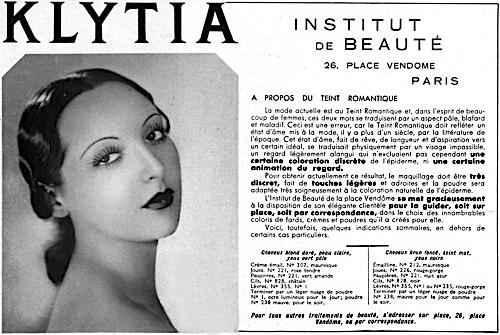
Above: 1937 Klytia recommendations for producing a romantic look.
Blonde:
Foundation: Crème Émail No. 307 – Mauresque.
Rouge: Crème de Roses No. 221 – Rose Tendre.
Eyeshadow: Crème de Roses No. 221 – Vert Amande.
Eyelashes: Klytiacil No. 828 – Châtain.
Lipstick: Paris Mediterranee No. 355 – Rouge-Gorge.
Powder: Poudre Klytia No. 1 – Ocre Luminex (day) then Poudre Élayne No. 238 – Mauve (night).
Brunette:
Foundation:Émailline No. 212 – Mauresque.
Rouge: Fards Impératrice No. 226 – Rouge-Gorge.
Eyeshadow: Crème de Roses No. 221 – Nuit Azur.
Eyelashes: Klytiacil No. 828 – Noir.
Lipstick: Either Paris Mediterranee No. 355 or Rouge Fixateur No. 235 – Rouge-Gorge.
Powder: Poudre Élayne No. 238 – Mauve (day or night).
(Klytia advertisement, 1937)

Above: 1939 Klytia Maquillage Tricolore.
War
It is difficult to know how badly Klytia was affected by the fall of France in June, 1940. The company would continue to have access to many European countries such as Germany, Austria, Italy, and Spain, but Britain was cut off and supplying Klytia’s South American markets would have been difficult if not impossible.
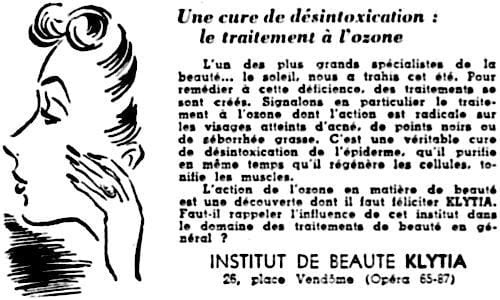
Above: 1941 Salon ozone treatment.
Some products disappeared during the war. For example, of the six préparations de grande beauté that existed before the war, only Émailline No. 212 and Beauté de l’Impératice No. 310 were still available in 1947. Some Klytia make-up also had their shade ranges reduced. Despite this Klytia was still able to produce a wide range of cosmetics during the Nazi occupation of Paris. Surprisingly, despite the Nazis, the Star of David remained on the older Klytia trademark when this was used on envelopes or the letterheads of invoices.
Timeline
| 1931 | New Products: Émail Pintanier No. 342; Crème Klytiafar No. 346; Nacrée Velours Klytia No. 347; Royal Klytia No. 348; and Crème Kytianet No. 353. |
| 1932 | New Products: Klytiaplasme No. 821. |
| 1934 | New Products: Paris-Méditerranée No. 355; and Crème Klytia Radium No. 827. |
| 1935 | Klytia Ltd. founded in London. New Products: Huile Phebus No. 289; and Klytiacil No. 828. |
| 1936 | Paris factory transferred to 148 Rue Victor-Hugo. New Products: Tamilklytia No. 840; and Masque Éclair No. 384. |
| 1937 | New Products: Automatique Klytia No. 843. |
| 1938 | New Products: Duvet de Pêche No. 844; Or Ambré No. 845; and Beauté de Iles No. 846. |
| 1939 | New Products: Poudre Elisabeth No. 850; Yaourt Klytia No. 851; and Epil-Gum No. 852. |
Continued onto: Klytia (post 1945)
First Posted: 18th January 2024
Sources
Klytia. (c.1930). Guide de la beauté [Booklet]. France: Author.
Klytia. (c.1939). La beauté c’est toute la femme [Booklet]. France: Author.
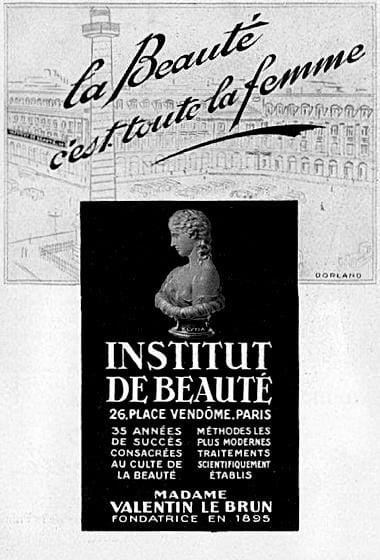
1930 Klytia.
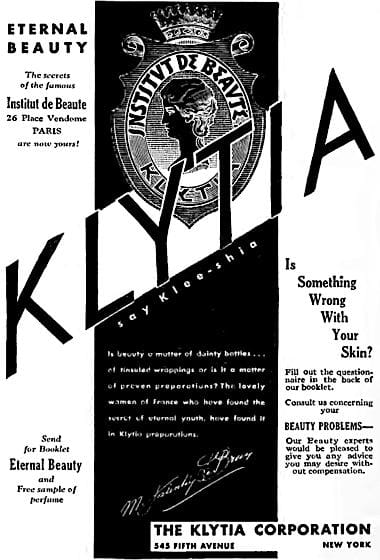
1930 Klytia Corporation (USA). Note that the Star of David is covered up.
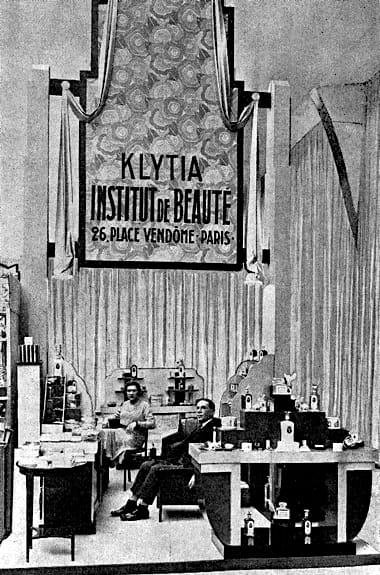
1931 Klytia Institut de Beauté exposition stand. The woman is Henriette Valentin Font [1885-1945], the man may be Vicomte M. Dean de Huigné. They were married in June, 1929.

New Klytia logo.
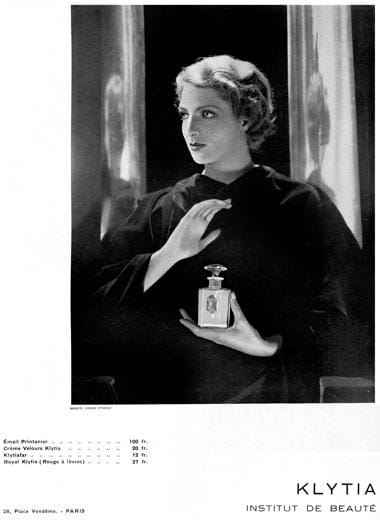
1931 Émail Pintanier No. 342, Crème Velours Klytia No 347, Klytiafar No. 346, and Royal Klytia No. 348. The model is holding a bottle of Émail Pintanier. Photograph by Horst P. Horst [1906-1999].
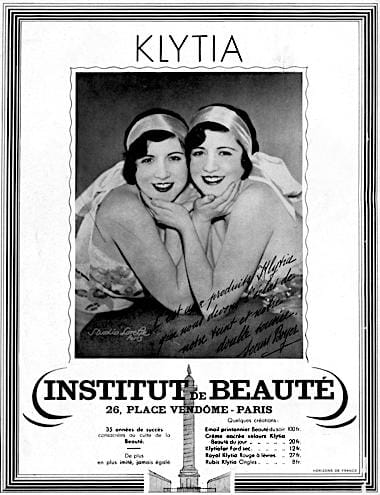
1932 Klytia featuring the Boyer Sisters.
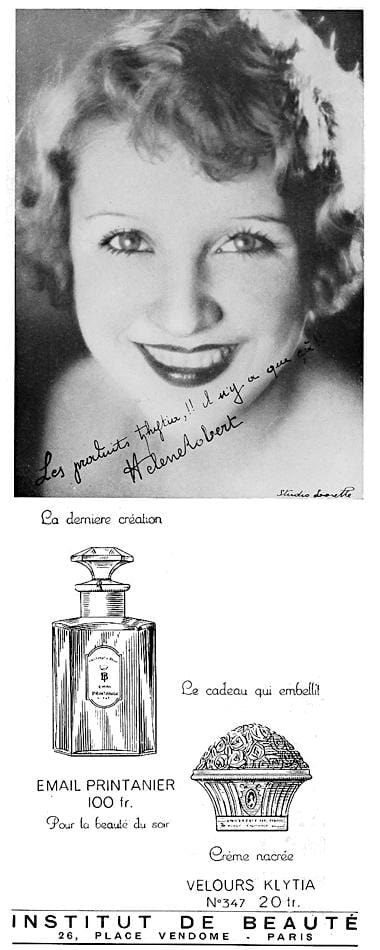
1931 Émail Pintanier No. 342, and Crème Velours Klytia No 347 in an ornate glass container.
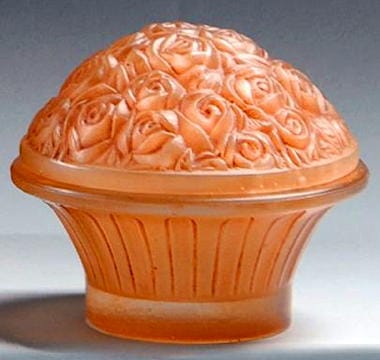
Crème Velours Klytia No. 347.
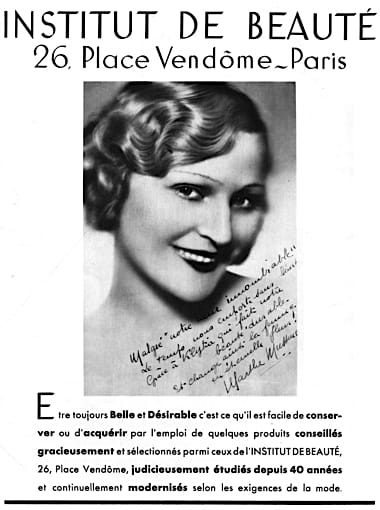
1933 Klytia Institut de Beauté.
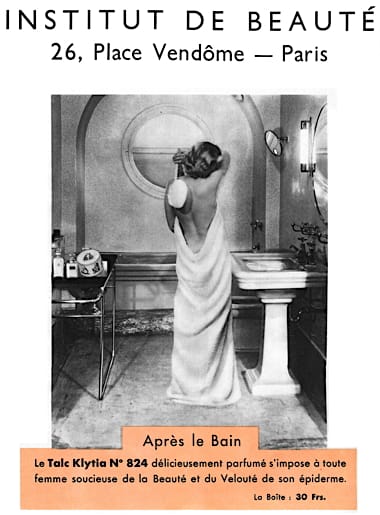
1934 Talc Klytia No. 824.
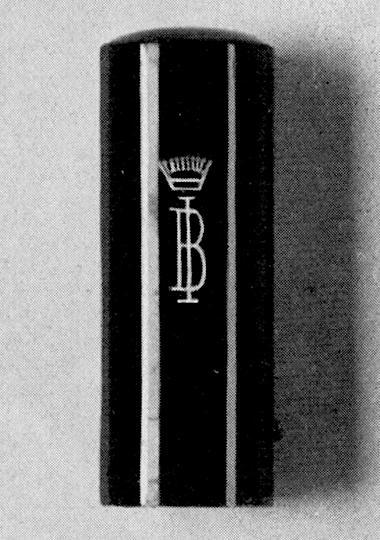
1934 Paris-Méditerranée No. 355 in a black Galalithe plastic case.

1934 Crème Radium No. 827, and Beauté des Yeux No.229 – mascara cake and brush.
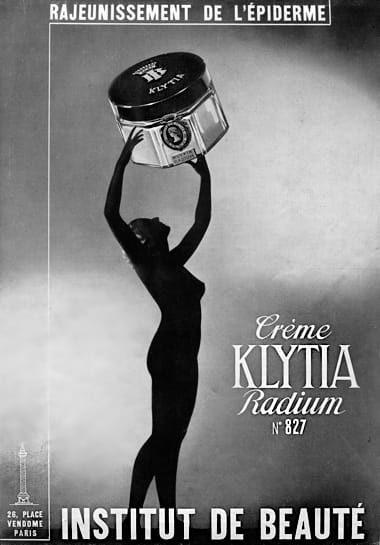
1935 Crème Klytia Radium No. 827. Klytia would rename it as Crème Klytia Radieuse, presumably removing any radium that was in the product.
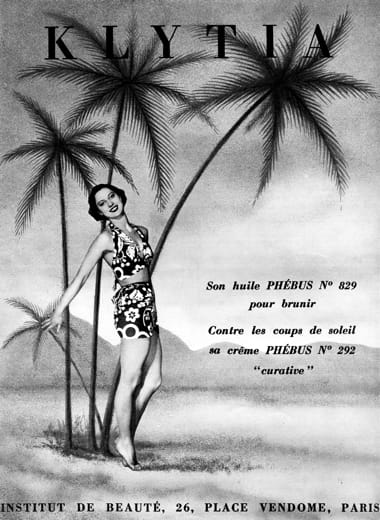
1935 Huile Phébus no. 829 and Crème Phébus No. 292.
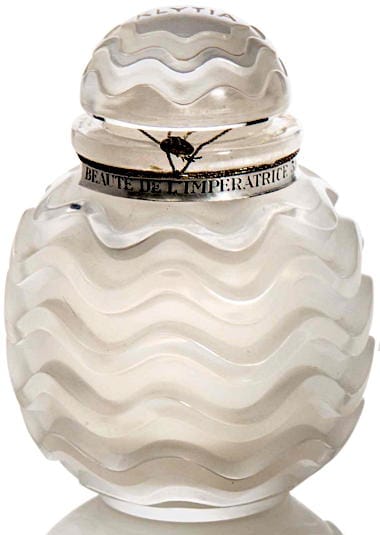
Klytia Beauté de l’Impératrice No. 310 previously known as Royal Beauté de l’Impératrice. It was repackaged in this René Jules Lalique [1860-1945] glass container around 1935. This has often been described as a Prends-Moi Pres de Toi perfume or lotion bottle rather than make-up.
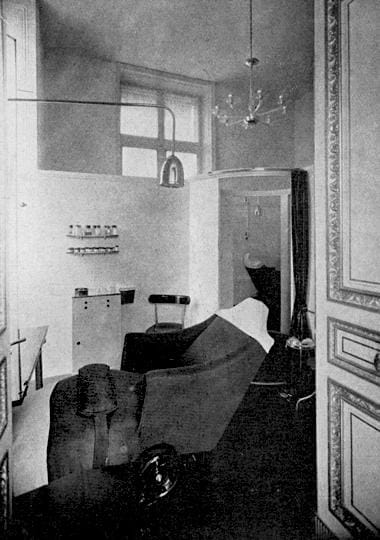
1936 Klytia Institut de Beauté treatment room. Rooms were decorated in pale pink, pale blue, or pale green with Surrepos chairs in red or green. There appears to be a shower at the back of the cub icle.
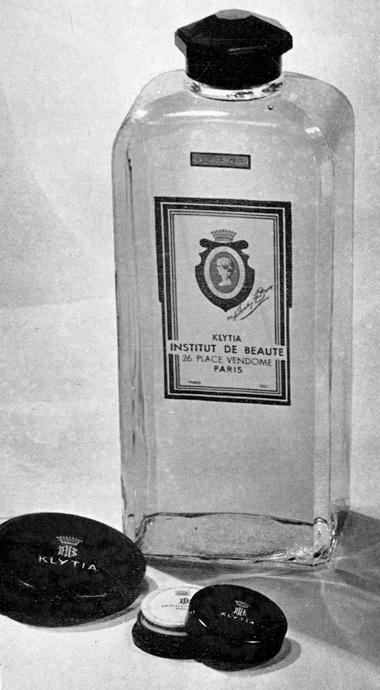
1936 A bottle of Exquis Printemps Parfum No. 800 and two different sized containers of Klytiafar No. 346 made from Galalithe plastic.
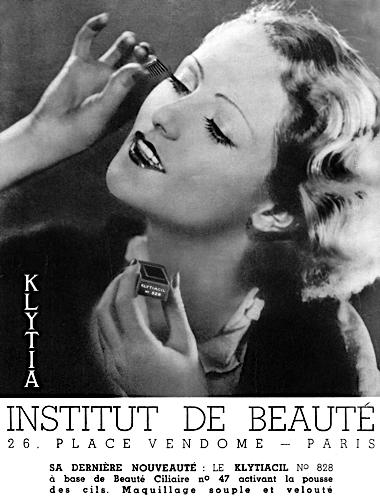
1935 Klytiacil No. 828.
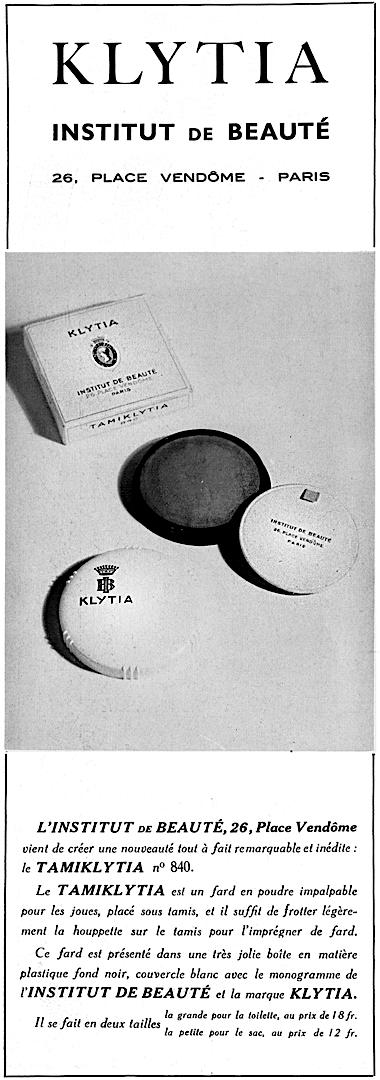
1936 Tamilklytia No. 840.
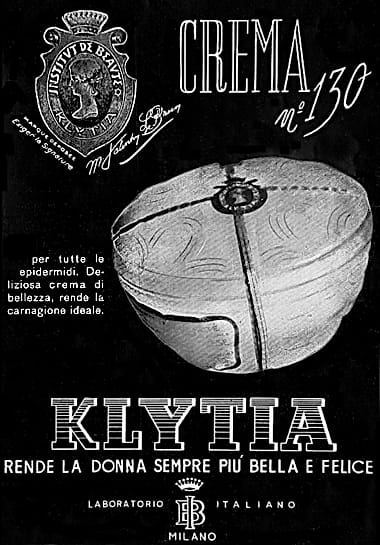
1937 Crema Klytia No. 130 (Italy).
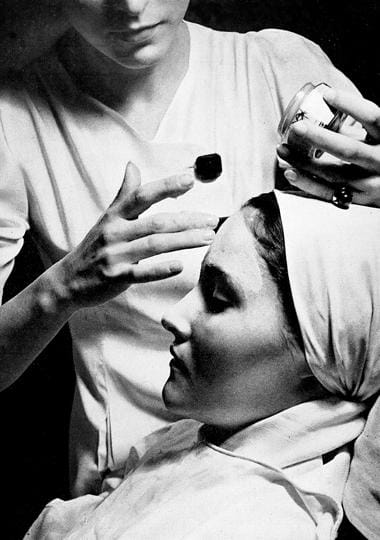
1937 Applying Crème Phébus No. 292 in the salon. It was used to soothe skin over exposed to summer sun or cold winter air.

1937 Klytia Institut de Beauté.

1937 Nail polish, lipstick, rouge, eyeshadow and foundation colour-coordinated with Coromandel.
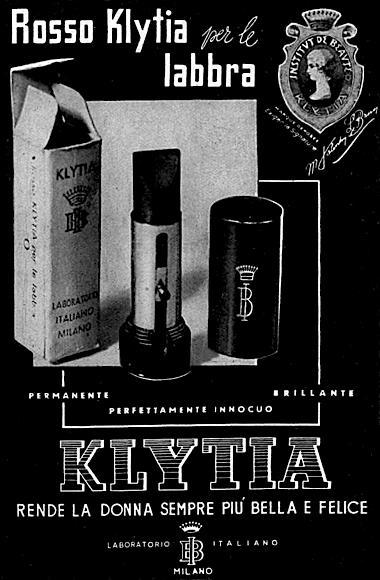
1937 Rosso Klytia No. 355 (Italy).
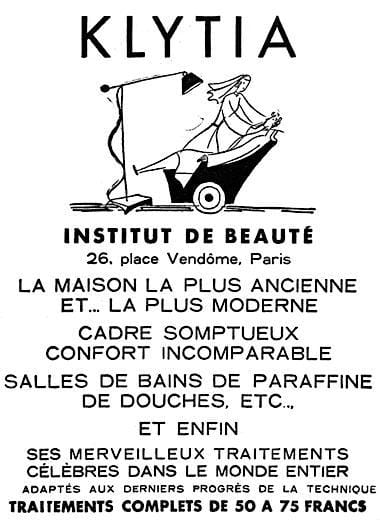
1937 Klytia Institut de Beauté.
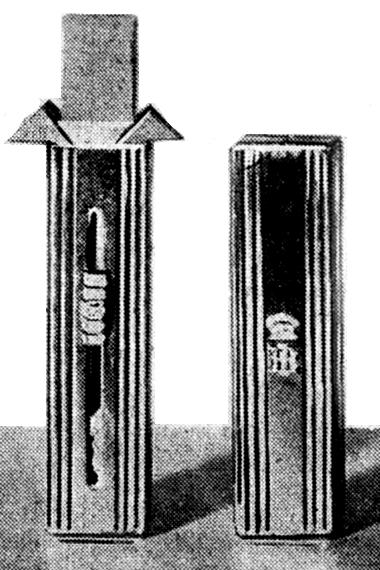
1937 Automatique Klytia No. 843 in a metal case.
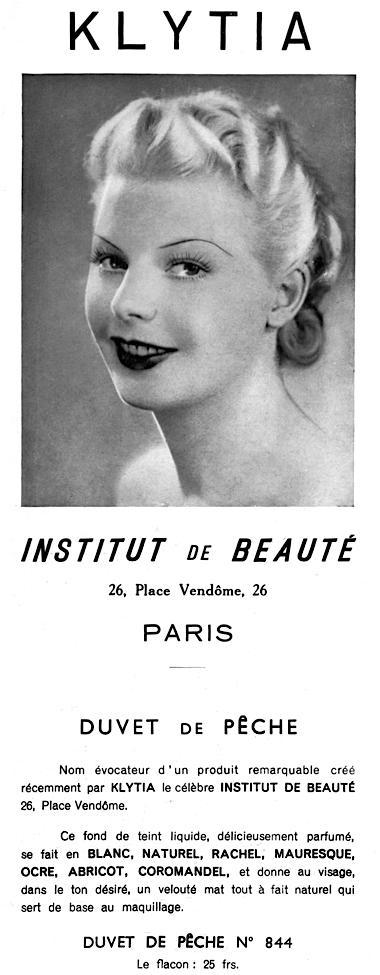
1938 Duvet de Pêche No 844.
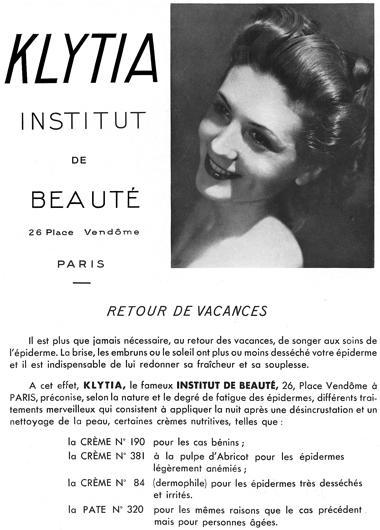
1938 Klytia Institut de Beauté.
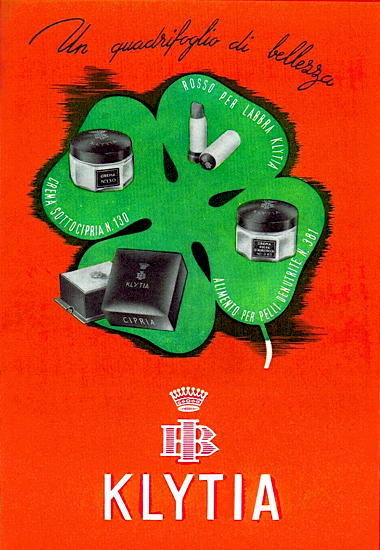
1944 Crema Mousse Mousse 130; Cipria Klytia No. 1, Crema Pulpa d’Albricocca No. 381, and Rosso Klytia No. 355 (Italy).
